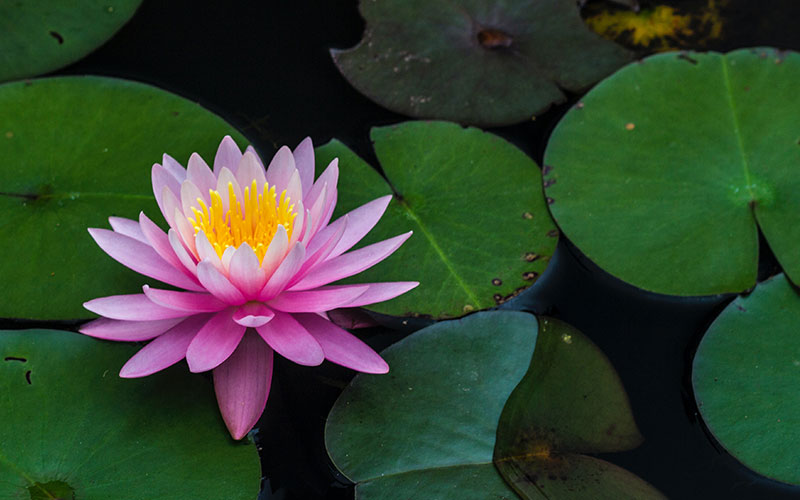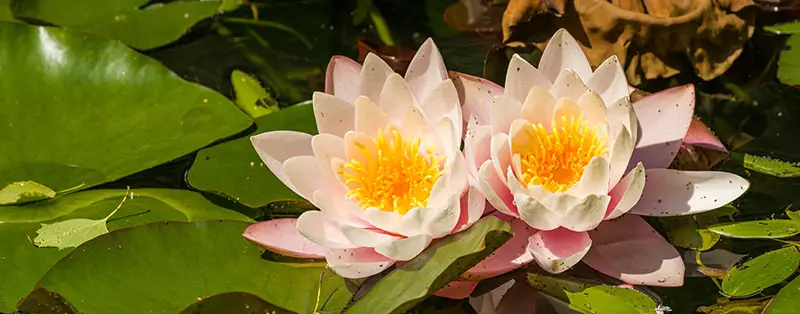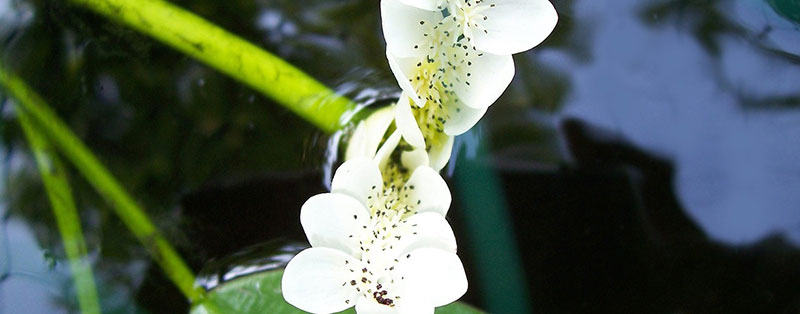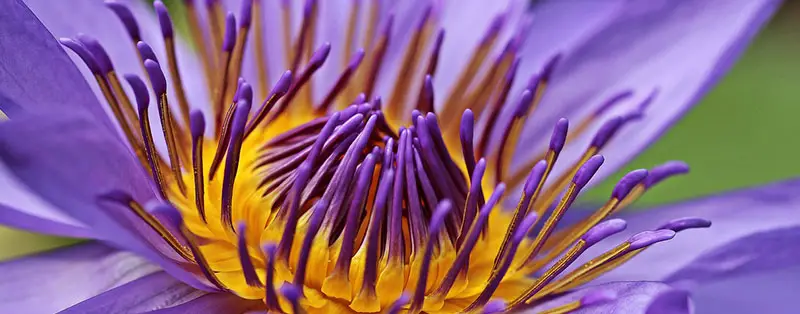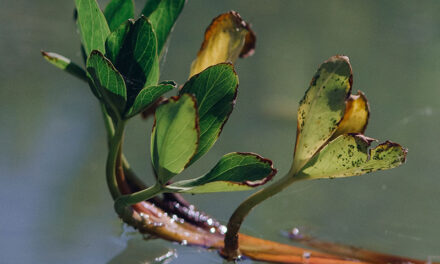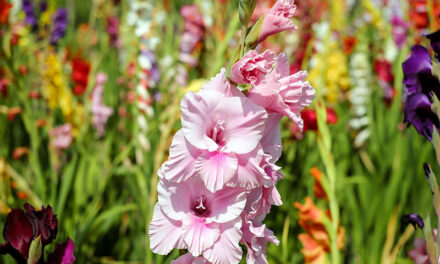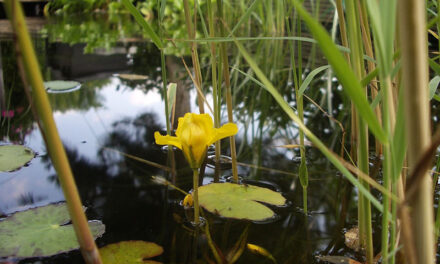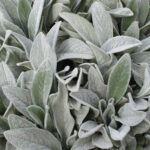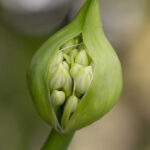Water lilies are rightly one of the most beautiful and striking pond plants. The water lily blooms from June till September and comes in different colours: white, yellow, pink and red. Not all water lilies are hardy plants, so keep this in mind when purchasing.
In addition to the decorative value of a water lily, the plant’s foliage provides shade to the animals and plants in the water. A water lily also has a biological function in your pond. It absorbs nutrients from the water, limiting algae growth. Read more about plants in and around your pond in the article How important are aquatic plants and marsh plants for the pond.
Water lily
Plant a water lily in a sunny spot in the pond. They are big lovers of the sun so make sure you put them in a spot where they can get this as much as possible. The minimum of four hours of sun per day is recommended. There are many different kinds of water lilies, they differ in size and color, and hardy or not winterhardy.
How does a water lily grow
The water lily can be bought as a cutting. It will grow slowly but steadily, starting with establishing a good root system. Therefore, make sure you have a spacious plant basket, so that your water lily has plenty of space to develop. In the beginning there won’t be a lot to see of the plant above water, so little leaf and little flower. But don’t worry, your patience will be rewarded.
Planting a water lily
A small water lily should be planted at least 40 centimeters below water, 60 centimeters is even better to prevent freezing in the winter. Large water lilies are best placed 80 centimeters deep. The water lily is planted in a plant basket with special soil specifically for them, they love fertile soil. You can also use pond soil, supplemented with clay. The planting period is in the month of May until September.
Buying a water lily, what should I pay attention to?
When buying a water lily there are a number of choices you can make.
- If your pond has a lot of sun exposure, you have plenty of choice. Water lilies need a lot of sun hours. If you have a less sunny spot, choose a water lily in a light color. The light coloured water lilies need slightly less sun than the darker coloured ones.
- Other than that, you should pay attention to the size of the water lily. There is a type that are suitable for small ponds and those that need more space and belong in a large pond.
- Make sure that you purchase a hardy water lily. Not all water lilies are suitable for surviving a winter with frost.
- There are special ‘dwarf’ water lilies if you want to have one on your garden table or for in your mini pond. You can put this in water with a depth of 10 centimeters.
- Water lilies unfortunately can not handle any movement in your water, so if you have a stream or a fountain, there is a small chance that your water lily will do well in your pond.
- To check the condition of the water lily pinch the root of your future purchase in store, it should feel firm. A soft tuber indicates rotting, so it’s better to leave this one alone.
Types of water lilies
The Latin name for water lily is Nymphaea.
White water-lily/ native water-lily
The white water lily has the Latin name Nymphaea Alba. When a white water lily grows in a pond, it is a sign that the water quality is good. The plant is seen in ponds or pools with a maximum depth of three meters. The white to light pink flowers bloom from May to August.
Cape pondweed
A very special aquatic plant is the Aponogeton Distachyos, the Cape pondweed. In the image below you can see what this special flower looks like. Multi-flowered white with black ‘dots’ on the petal, it is a beautiful flower that originates from South Africa. The flowers appear in the months of April and May and smell like a vanilla-like scent, they often bloom again during the year. A downside of the plant is that it must get through the winter frost-free. So you either have to remove them from your pond, or put them so deep that a frost can’t get in.
Egyptian water lily
Nelumbo Nucifera or Nymphaea Lotus, Egyptian white water lily are some of the names by which this flower is known. The water lily and the lotus may seem like they have similarities at first glance, but are surprisingly not related to each other. The most noticeable difference is that the lotus flowers bloom on a stem above the water and the water lilies float on water on a stem that is not visible. This plant is not hardy, unless planted deep enough.
Purple tropical water lily
Nymphaea Purple Joy is a striking water lily with purple flower tips that bloom between June and August. With the purple water lilies, pay attention to whether they are hardy. Many are not. This kind belongs to the small species and should be planted in about 30 centimeters deep water.
Red water lily
Nymphaea Escarboucle is a large water lily species with large carmine red flowers. The diameter of the flowers is 30 centimeters and has a special quality of having a very pleasant scent.
Blue water lily
The blue Nymphaea King of Blues is a water lily with flowers that have a diameter of about 18 centimeters. It is a tropical species that is not hardy. So during winter you can store and keep these water lilies safe in a cellar or in the attic. This species belong to the medium-sized water lilies and can be planted in 30 to 50 centimeters below water.
Dwarf and Miniature water lily
Nymphaea Indiana is an orange coloured dwarf water lily. The Nymphaea Pygmea Alba is also a dwarf species with smaller flowers and are suitable for a mini pond.
Water lily care
Prune water lilies
It is best to prune dead leaves and faded flowers during the flowering season. This prevents the pond from becoming too nutrient-rich. During autumn when the plant dies, cut off all the leaves with a pruning knife. If you do not pull them away rotting spots can develop which are not good for the health of the plant.
Water-lily nutrition
The food for the plant is supposed to be added specifically to the plant basket for the roots of your water lily, this is the so-called ‘growth bulb’. These bulbs are specially made for fertilising water lilies. They contain nutrients, minerals and trace elements. You can add this every 6 to 8 weeks in the basket during the period of March till July, in which the roots of the water lily grow.
Aphids in your water-lily
You can treat the aphids on a water lily in the same manner like on a plant. Choose the ecological way by having them consumed by ladybugs. An additional solution is having fish in the pond as they also consume these insects. Aphids cannot survive under water, so if you keep the leaves of your water lily under water for a while your aphids will soon be gone. Read more about controlling aphids.

